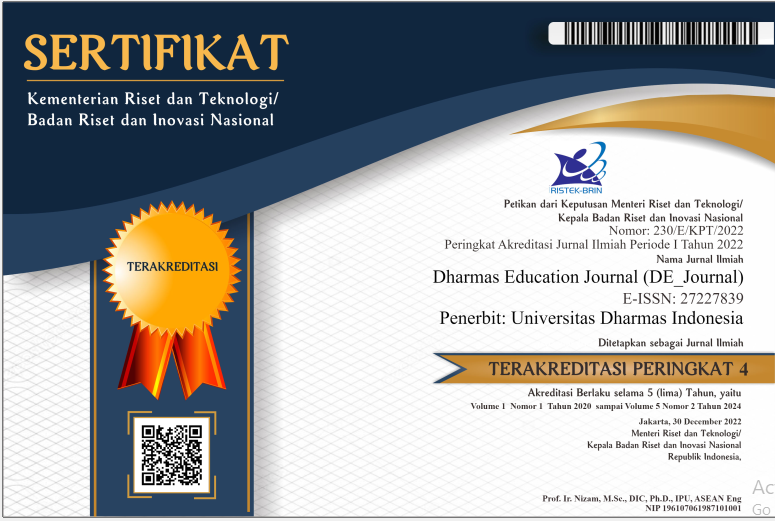CULTURAL ADJUSTMENT IN INDONESIAN TEXT’ TRANSLATION “TOBA BATAK TRADITIONAL CEREMONY” INTO ENGLISH
DOI:
https://doi.org/10.56667/dejournal.v4i3.1433Kata Kunci:
Cultural Adjustment, Translation, Source Language, Target Language, Translation TechniquesAbstrak
Cultural adjustments are essential in the translation process, particularly when translating from Indonesian to English, due to the unique cultural nuances, customs, and expressions inherent in each language. Without careful consideration, these elements can easily be lost in translation. One major challenge is the cultural differences between Indonesian and English. Another challenge is the distinction between formal and informal language usage in both languages. To address these challenges, translators need a profound understanding of both the source and target languages and cultures. They must be well-versed in the cultural norms, customs, and expressions of both languages and adapt them appropriately in their translations. This study examines the translation techniques used to achieve cultural adjustments when translating Indonesian texts into English and how these adjustments are realized by the translator. A qualitative approach is employed, specifically descriptive research, aiming to provide a detailed description of existing translations. The data source for this research is the translation work of an English lecturer at the University Prima Indonesia. The translation techniques identified include adaptation, adoption uptake, common/established equivalence, discursive creation, compensation, and variation. The findings indicate that adoption uptake is the predominant technique used by the translator to achieve cultural adjustments from Indonesian to English.
Unduhan
Referensi
Fitria, R. A., Sabarun, S., & Miftah, M. Z. (2022). Students’perception Of The Use Of Grammarly In Undergraduate Thesis Writing. Project (Professional Journal Of English Education), 5(2), 366–371.
Fitriana, K., & Nurazni, L. (2022). Exploring English Department Students’ Perceptions On Using Grammarly To Check The Grammar In Their Writing. Journal Of English Teaching, 8(1), 15–25. Http://Ejournal.Uki.Ac.Id/Index.Php/Jet
Ginting, R. I., Lubis, B. N. A., & Sinaga, D. A. (2021). The Revitalization Of Tugu Silalahi Batak Toba Folklore Into Teaching Materials In English Subject For Junior High School. Linguistic, English Education And Art (Leea) Journal, 4(2), 240–248. Https://Doi.Org/10.31539/Leea.V4i2.1840
Herman, H., Purba, R., Sitohang, D. R., Van Thao, N., & Trang, P. T. Q. (2022). How To Attract Viewers Through Advertisement Slogans? A Case On Figurative In Semantic Study. Universal Journal Of Social Sciences And Humanities, 1–5.
Ifadloh, N., Warsono, W., & Faridi, A. (2021). The Comparison Of Lexical Collocations In English Textbooks Used In Indonesia. English Education Journal, 11(3), 434–443. Https://Doi.Org/10.15294/Eej.V11i1.47254
Kosasih Galingging, C., & Tannuary, A. (2022). Contrastive Analysis Between English And Indonesian Quotes In The Utterances Of The Character In The Movie “ Doctor Strange 2 Multiverse Of Madness”. Journal Of Social Science And Humanities Research, 1(1), 1–11. Https://Doi.Org/10.56854/Jsshr.V1i1.47
Lestari Kasih Grasella Nahampun, Herman, Christina Natalina Saragi, & Nanda Saputra. (2022). The Contrastive Analysis Of The Sound In Vowel And Consonant In English And Batak Language. Linglit Journal Scientific Journal For Linguistics And Literature, 3(2), 87–92. Https://Doi.Org/10.33258/Linglit.V3i2.724
Lismayanti, D., & Pratama, A. (2019). An Analysis Of Students’ Ability In Applying Modulation Technique In Translating Collocation “The Lost Symbol” Novel By Dan Brown. Edu-Ling: Journal Of English Education And Linguistics, 3(1 December), 182–189. Http://Repository.Iainbengkulu.Ac.Id/Id/Eprint/3778
Lowenthal, P. R., & Trespalacios, J. (2022). Classroom Community And Time: Comparing Students’ Perceptions Of Classroom Community In Traditional Vs. Accelerated Online Courses. Online Learning, 26(4).
Lumbanbatu, S., Jufrizal, J., & Wahyuni, D. (2018). An Analysis Of Address Terms Based On Kinship System Of Batak Toba Used By Bataknesse In Padang. English Language And Literature, 7(1). Http://Repository.Uhn.Ac.Id/Handle/123456789/1455
Marbun, S., Silalahi, D. E., & Herman, H. (2021). Telling People To Change Their Behaviour Through Implications: An Implicature Analysis On Covid-19 Public Service Announcements In Indonesia. Elsya : Journal Of English Language Studies, 3(3), 215–224. Https://Doi.Org/10.31849/Elsya.V3i3.6336
Ni’mah, H., Kurniawati, D., & Susatyo, B. (2022). Analyzing Lecturer Classroom Management Style In English Class At Unirow Tuban. Prosiding Snasppm, 7(1), 1057–1063.
Pasaribu, S. H., Tampubolon, A., Sidauruk, A., & Napitupulu, S. (2022). Contrastive Analysis Between English And Batak Toba Language In Question Word. Journal Of Humanities, Social Sciences And Business (Jhssb), 1(4), 89–98. Https://Doi.Org/10.55047/Jhssb.V1i4.267
Sari, B. N., & Gulö, I. (2019). Observing Grammatical Collocation In Students’ Writings. Teknosastik, 17(2), 25. Https://Doi.Org/10.33365/Ts.V17i2.325
Sianipar, E. O., Herman, H., & Purba, R. (2022). A Contrastive Analysis Study Between English And Batak Toba In Request Sentence. Edu-Ling: Journal Of English Education And Linguistics, 5(2), 176. Https://Doi.Org/10.32663/Edu-Ling.V5i2.2982
Sianipar, H. M. (2022). A Contrastive Analysis Between English And Batak Toba Language In Prefixes. The Explora, 8(2), 35–44. Https://Doi.Org/10.51622/Explora.V8i2.644
Sibarani, R. (2018). Batak Toba Society’s Local Wisdom Of Mutual Cooperation In Toba Lake Area: A Linguistic Anthropology Study. International Journal Of Human Rights In Healthcare, 11(1), 40–55. Https://Doi.Org/10.1108/Ijhrh-08-2017-0035
Simanihuruk, B., & Mulyadi, M. (2020). Interjection Bah! In Batak Toba: A Natural Semantic Metalanguage Approach. Studies In English Language And Education, 7(1), 209–222. Https://Doi.Org/10.24815/Siele.V7i1.15433
Simanjuntak, M. B., Lumingkewas, M. S., & Sutrisno, S. (2021). Analysis Of Tangiang Ale Amanami (Our Father) Using The Techniques Of Translation. Journal Of Advanced English Studies, 4(2), 70–75. Https://Doi.Org/Http://Dx.Doi.Org/10.47354/Jaes.V4i2.117
Simanjuntak, N., Simaremare, R. M., Saputra, N., Ngongo, M., & Herman, H. (2022). ‘We All Are Perfectly Imperfect’: An Interpersonal Metafunction Of Muniba Mazari’s Speech In A Case On Systemic Functional Linguistics. English Review: Journal Of English Education, 10(3), 793–800. Https://Doi.Org/10.25134/Erjee.V10i3.6326
Tampubolon, S. (2020). A Comparative Study Of Kinds, Function, And Position Of Question Words In English And Bahasa Batak Toba. Jurnal Suluh Pendidikan, 8(2), 71–79. Https://Doi.Org/10.36655/Jsp.V8i2.326
Tampubolon, S., & Panggabean, R. (2020). An Analysis Of Kinds, Function, And Position Of Question Words In English And Bahasa Batak Toba 2020. Http://Repository.Uhn.Ac.Id/Handle/123456789/6093
Villyastuti, Y. W., Raharjo, T. J., Sugiyo, & Rusdarti. (2022). Effect Of Education Programs Specialist Doctors To Changes Behavior Of Students In The Pandemic Covid-19. 6th International Conference On Science, Education And Technology (Iset 2020), 708–711. Https://Doi.Org/10.2991/Assehr.K.211125.134
Zaabalawi, R. S., & Gould, A. M. (2017). English Collocations: A Novel Approach To Teaching The Language’s Last Bastion. Ampersand, 4, 21–29. Https://Doi.Org/10.1016/J.Amper.2017.03.002
Unduhan
Diterbitkan
Cara Mengutip
Terbitan
Bagian
Lisensi
Hak Cipta (c) 2024 Dharmas Education Journal

Artikel ini berlisensi Creative Commons Attribution-NonCommercial-NoDerivatives 4.0 International License.
Makalah yang disampaikan diasumsikan tidak mengandung bahan propietary yang tidak dilindungi oleh hak paten














